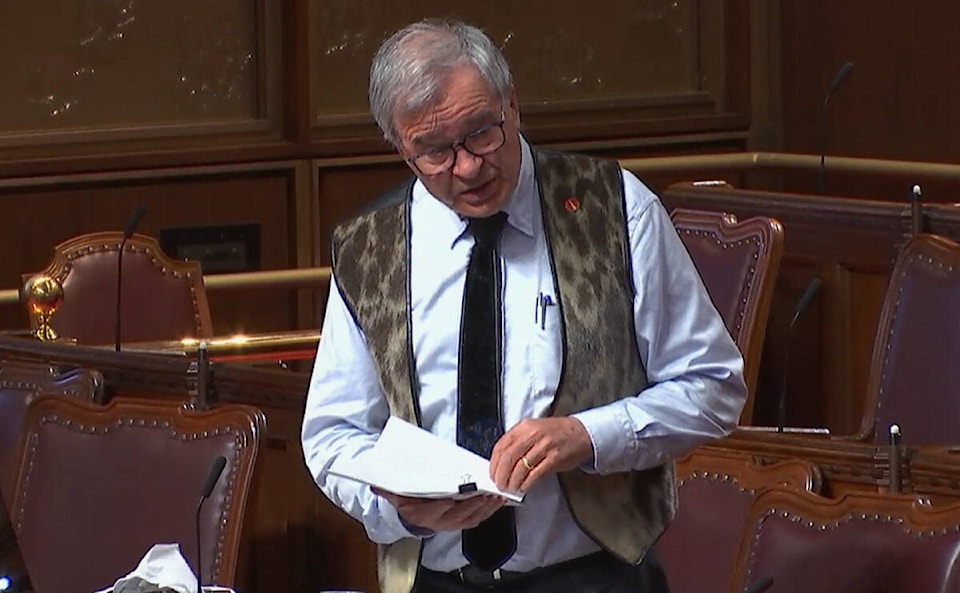Nunavut Senator Dennis Patterson has appealed to his colleagues for more action on suicide prevention and less time devoted to studying the issue.
Speaking in the Senate on March 31 and addressing a motion made by fellow Senator Stan Kutcher to examine the federal government’s framework for suicide prevention, Patterson said no more time can afford to be lost.
“In Nunavut, we cannot wait for more recommendations. Every year without action is another year of lost lives and pain,” he said. “Suicide is a very important issue, but I’m wary of yet another study. My constituents in Nunavut who are dealing with suicide and its impacts every day need action instead of more studies.”
Cecile Guerin, executive director with the Isaksimagit Inuusirmi Katujjiqatigiit Embrace Life Council (IIKELC), said she agrees with Patterson.
“At this point we definitely need more hands-on actions and no more studies,” she said.
Patterson recited some existing suicide prevention strategies already in place: the Federal Framework for Suicide Prevention; the National Inuit Suicide Prevention Strategy; the First Nations Mental Wellness Continuum Framework; the Mental Health Strategy for Canada; and Changing Directions, Changing Lives. He noted that many of these strategies are designed by southerners who are non-Inuit. He said Inuit must be involved in any reviews that take place and that it may involve assessments of existing programs that southerners may not connect with suicide, but Inuit see things differently.
What Nunavummiut need most, he asserted, is multi-year, flexible federal funding and a whole-of-government approach.
Guerin noted that the IIKELC only receives funding from the Government of Nunavut, not from the federal government, but the latter would be welcome “to address operational/programming need shortfalls.” Additional financial resources would also allow the organization to address all action items in its action plan, she added.
“The IIKELC team has grown over the past few years and we still have a lot of work to do. More office spaces and staff would definitely be a great benefit for the organization and communities. We are a small team that carries a big mandate,” said Guerin.
The senator said he’s been approached by constituents asking him to help find ways to prevent others from taking their own lives.
The suicide rate among Inuit was approximately nine times higher than among Canada’s non-Indigenous population between 2011 and 2016, according to Statistics Canada.
“There are many reasons behind a suicide, but we do not really know what the trigger is,” Patterson said in Inuktitut on the Senate floor.
He pointed to historical factors such as the residential school experience, forced relocation of Inuit, the Inuit dog slaughter and tuberculosis, along with mental illness, the housing crisis, the banning of sealskins in Europe, as causes of trauma and harmful behaviour.
Patterson urged that training be provided to Inuit and that suicide prevention resources exist in communities around the clock.
“Inuit should be involved in administering programs or delivering programs based on their knowledge, Inuit knowledge, because they know their land and their environment the best,” he said. “Longtime Northerners know what those programs should be because we’ve heard the decades of discussions and read many studies that all say the same thing: Nunavummiut need programs that help them learn cultural skills and get them back on the land.”
He cited hunting, how to manufacture and maintain hunting equipment and preparing and sewing sealskins as examples of integral knowledge to impart.
“While this may not seem connected to suicide prevention, it is important to know that all these skills are ennobling and uplifting,” said Patterson, who added that it’s also essential for programs to be delivered in Inuktut. “A deeper connection to one’s culture gives strength and stability. Trades and hobbies give purpose, as opposed to folks seeking to fill the void with drugs and alcohol.”
Guerin noted that the IIKELC works with community members to offer most of its programming “so we definitely have taken steps to deliver the programs in Inuktut.”
The programs are offered based on the needs of the community and what people want to learn. Program coordinators from the three offices consult with their community what kind of programs would be needed and what are the gaps,” she said.
Patterson also stated that it’s important to recognize Elders as knowledge-keepers, and he made reference to an Elder who told him that cultural perspectives need to be prominent again to prevent suicides.
He added that there would be too much time lost to studying 20 years of federal suicide initiatives by a Senate committee that meets once a week and which would be “bogged down” by legislation.
